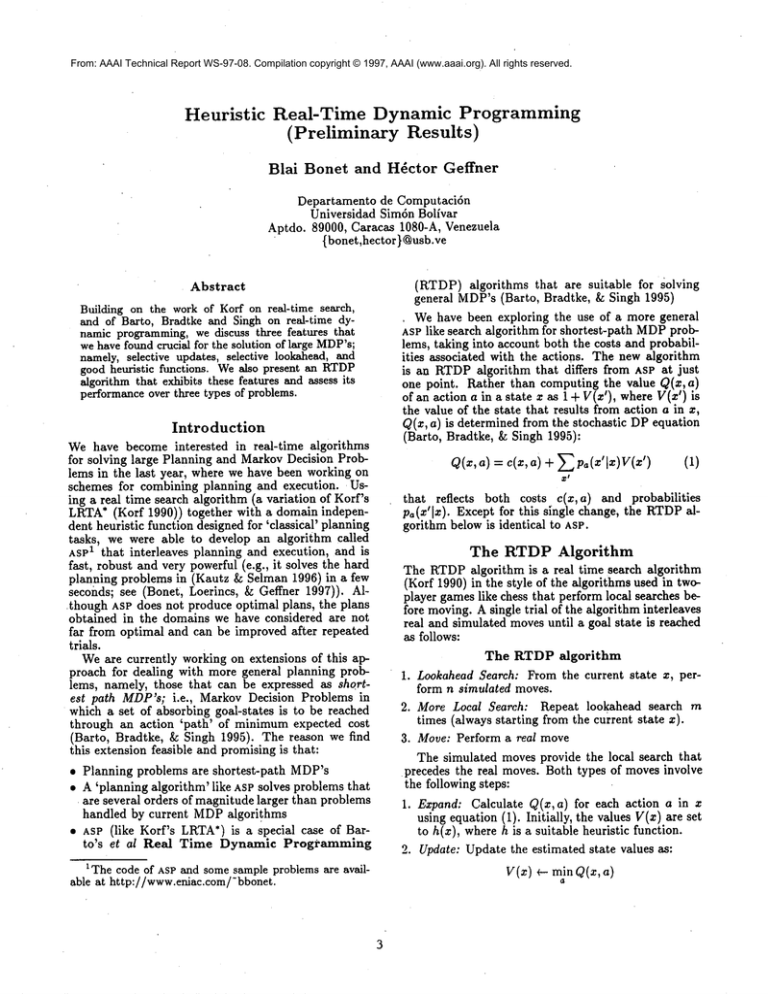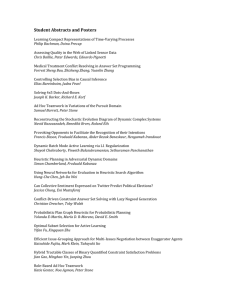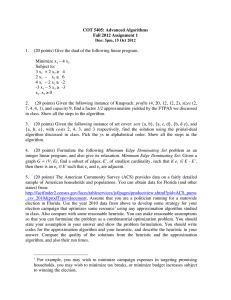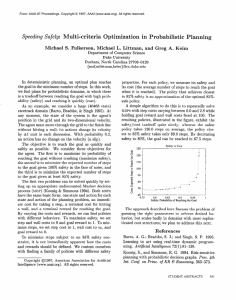
From: AAAI Technical Report WS-97-08. Compilation copyright © 1997, AAAI (www.aaai.org). All rights reserved.
Heuristic
Real-Time
Dynamic
Programming
(Preliminary Results)
Blai Bonet and Hdctor Geffner
Departamento de Computacidn
Universidad Simdn Bolivar
Aptdo. 89000, Caracas 1080-A, Venezuela
{bonet,hector}@usb.ve
Abstract
Building on the work of Korf on real-time search,
and of Barto, Bradtke and Singh on real-time dynamic programming, we discuss three features that
we have found crucial for the solution of large MDP’s;
namely, selective updates, selective lookahead, and
good heuristic functions. Wealso present an RTDP
algorithm that exhibits these features and assess its
performanceover three types of problems.
Introduction
We have become interested
in real-time algorithms
for solving large Planning and Markov Decision Problems in the last year, where we have been working on
schemes for combining planning and execution. Using a real time search algorithm (a variation of Korf’s
LRTA*(Korf 1990)) together with a domain independent heuristic function designed for ’classical’ planning
tasks, we were able to develop an algorithm called
ASP1 that interleaves planning and execution, and is
fast, robust and very powerful (e.g., it solves the hard
planning problems in (Kautz ~ Selman 1996) in a few
seconds; see (Bonet, Loerincs, ~ Geffner 1997)).
though ASPdoes not produce optimal plans, the plans
obtained in the domains we have considered are not
far from optimal and can be improved after repeated
trials.
Weare currently working on extensions of this approach for dealing with more general planning problems, namely, those that can be expressed as shortest path MDP’s; i.e., Markov Decision Problems in
which a set of absorbing goal-states is to be reached
through an action ’path’ of minimumexpected cost
(Barto, Bradtke, ~ Singh 1995). The reason we find
this extension feasible and promising is that:
¯ Planning problems are shortest-path
MDP’s
¯ A ’planning algorithm’ like ASP solves problems that
¯ are several orders of magnitude larger than problems
handled by current MDPalgorithms
¯ ASP (like Korf’s LRTA*)is a special case of Barto’s et al Real Time Dynamic Progi-amming
1 The code of ASPand somesample problems are available at http://www.eniae.com/’bbonet.
(RTDP) algorithms that are suitable for solving
general MDP’s(Barto, Bradtke, ~ Singh 1995)
We have been exploring the use of a more general
ASPlike search algorithm for shortest-path MDPproblems, taking into account both the costs and probabilities associated with the actions. The new algorithm
is an RTDPalgorithm that differs from ASP at just
one point. Rather than computing the value Q(x, a)
of an action a in a state x as 1 + V(x’), where V(x’)
the value of the state that results from action a in x,
Q(x, a) is determined from the stochastic DPequation
(Barto, Bradtke, ~ Singh 1995):
Q(x,a)= c(x, a) + po( ’lx)v(x’)
eX
that reflects both costs c(x,a) and probabilities
pa(X’lx). Except for this single change, the RTDPalgorithm below is identical to ASP.
The RTDP Algorithm
The RTDPalgorithm is a real time search algorithm
(Korf 1990) in the style of the algorithms used in twoplayer games like chess that perform local searches before moving. A single trial of the algorithm interleaves
real and simulated movesuntil a goal state is reached
as follows:
The RTDP algorithm
1. Lookahead Search: From the current state x, perform n simulated moves.
2. More Local Search: Repeat lookahead search m
times (always starting from the current state x).
3. Move: Perform a real move
The simulated moves provide the local search that
¯ precedes the real moves. Both types of moves involve
the following steps:
1. Expand: Calculate
using equation (1).
to h(x), where h is
2. Update: Update the
Q(x,a) for each action a in z
Initially, the values V(x) are set
a suitable heuristic function.
estimated state values as:
V(x) ~ minQ(x,a)
a
3. Go: Apply the action a that has a minimumQ(z, a)
value, breaking ties randomly.
The only difference between real and simulated
moves is that the former affect the current state of
the system while the later only affect the current state
of the system in the simulation.
The local search above differs from the local search
in Korf’s LRTA*and related algorithms (e.g., (Dearden ~ Boutilier 1994)) in two ways. First, the search
within the local space is guided by the value function
V and is not exhaustive (it visits at most m× n states).
Second, during the lookahead, the value function of every state visited is updated (that’s the reason it makes
sense to repeat the lookahead search m times). These
two features have a considerable effect on performance
and both are considered in (Barto, Bradtke, & Singh
1995) (see below). Also, as proven in (Barto, Bradtke,
Singh 1995), after a sufficient numberof trials (see
also (Korf 1990)), this type of algorithm is guaranteed
to converge to the optimal ’path’ when the heuristic
function h(z) used to initialize the values of the states
is optimistic. In the experiments below, however, only
single trial versions of the algorithm are considered.
The Power of Heuristic
Algorithms
RTDP
Planning problems are simple MDP’sas they ignore
probabilities and costs yet that alone does not explain
the performance of algorithms like ASPthat appear to
handle very large problems (e.g., 1025 states) producing solutions whose costs do not exceed the optimal
costs in more than 50%. Webelieve that the explanation for these results rests mainly in three features;
namely, real time updates, good heuristic func=
tions and selective looknhed:
¯ real time DP algorithms
(and other asynchronous DP algorithms) do not consider the whole
space of the problem but only the states that result from the actions of the agent. Whenthe initial
heuristic estimates are optimistic, this is guaranteed
to focus the updates on states that are relevant (Korf
1990; Barto, Bradtke, & Singh 1995). A different
method for isolating the part of the space that is
relevant is given in (Dean et al. 1993).
¯ the selectivity of RTDPalgorithms is further increased by the use of good heuristic functions for
initializing the values of the states whenthey first are
visited (Korf 1990). These heuristics can be crafted
by hand or can be derived from suitable representations (Dearden & Boutilier 1994). In the planning
problems we considered, the heuristic function was
derived automatically from a Strip-like representation and made a huge difference in the results in
spite of not being even optimistic (Bonet, Loerincs,
Geffner 1997).
¯ the imperfections in the heuristic function can often be smoothed by looking ahead far enough.
Yet, local search methods are often exhaustive (with
the exception of some pruning; see (Korf 1990;
problem
blocks_l
blocks_2
blocks_3
blocks_4
opt.
6
9
14
18
steps
II
14
23
31
time
0.40
0.65
3.17
12.97
visited
195
306
645
1034
space
64.6-10
s8.2. l0
ta
6.6. IO
t9
1.4.10
Table I: RTDPwith minimal lookahead (m = n = 1)
on four block world planning problems
Dearden & Boutilier 1994)) and thus grow exponentially in the depth of the local space. An alternative that paid off in our experience was to search
the local space by hill climbing making use of the
estimated state values to guide the search. This actually corresponds to the combination of real and
simulated moves discussed in (Barto, Bradtke,
Singh 1995) and in other places (e.g., (Sutton 1990)).
Also, by updating the state values as the local space
is explored and by repeating this process a number
of times, useful information about the local search
space can be gathered that may lie at considerable
depth in the search graph (see below).
Some Experimental
Results
The experiments below illustrate the impact on performance of the three main features discussed: real time
updates, good heuristic functions and selective
looknhed.
The first set of experiments illustrate the synergy
that results from the use of a good heuristic function
with an RTDPalgorithm. Table 1 shows the results
of the RTDPalgorithm with the planning heuristic reported in (Bonet, Loerincs, &Geffner 1997) and minimal lookahead (i.e., n = ra - 1)over four block world
planning problems involving 9, 11, 15 and 19 blocks
respectively (see (Kautz & Selman 1996)). In these
cases the problems are solved very fast and only a tiny
fraction of the state space is visited (columns 5 and
6). The cost of the solutions (column 3) in almost
these cases is 50% above the optimal costs (column
2). These solutions can be improved in two ways: by
either increasing the lookahead parameters n and m,
or performing repeated trials (see (Bonet, Loerincs,
Geffner 1997) for the results in both cases). In any
case, it’s clear that for these type of problems, optimal
but exhaustive techniques like value iteration are not
applicable. Moreover, the same RTDPalgorithm with
a non-informative heuristic function, h(x) = 0, does
not find solutions to any of the problems.
The second experiment illustrates
the value of selective lookahead (Table 2) as opposed to exhaustive
lookahead (Table 3) over an instance of the 8-puzzle.
In the first scheme, the best tradeoffs are obtained for
approximated 18 simulated moves in each local search
for a fixed number mof local searches equal to 10. In
this case the solution is found after 3.25 seconds and
has a cost of 31 (optimal cost is 24). Table 3 shows
the result of replacing the selective local search by aa
n=l
n=2
n=3
n=4
n=5
n=6
n---7
n=8
n=9
n=lO
n=12
n= 14
n=16
n=18
n=20
n--22
n=24
steps
397.05
124.95
146.95
103.65
99.25
79.65
66.25
55.25
49.60
50.00
33.55
38.30
36.90
31.80
34.15
34.00
35.05
time
3.32
2.05
3.20
3.07
3.45
3.27
3.32
3.07
2.97
3.45
2.52
3.30
3.62
3.25
3.87
4.17
4.85
Table 2: RTDPwith selective lookahead (m = 10 and
variable n) over an instance of the 8-puzzle
d=l
d=2
d=3
d=4
d=5
d=6
d=7
d=8
d=9
d=10
steps
349.7
188.0
135.0
110.0
114.5
81.2
69.2
65.2
time
0.55
0.80
1.75
3.90
11.00
22.38
53.13
141.60
Table 3: RTDPwith exhaustive lookahead and depth
d over same instance of 8-puzzle
exhaustive local search up to a depth represented by
the parameter d. Clearly the time taken to explore this
local space grows exponentially, and even with a depth
d = 8 and time equal to 141 seconds, we don’t get a
~
solution of the same quality.
Finally, Table 4 shows RTDPsolutions to a stochastic ’race track’ problem as the one reported in (Barto,
Bradtke, &; Singh 1995), where the goal is to go around
the track in a minimal number of actions (x and
accelerations).
The problem we considered involves
around 100,000 states that result from the different
positions and velocities of the car, and can be solved
by value iteration in 12 minutes. The expected cost
of the optimal solution is 20. Columns 2-3 and 4-5
show the number of steps and seconds taken by RTDP
solutions involving a non-informative heuristics h = 0
and an informative heuristics (a composition of aerial
distances), for different numbers n of simulated moves
:The numberof steps reported in each table are averages
as different runs of the algorithmsyield different results due
to the random tie breaking mechanism.
h 0
h#0
steps time
steps ] time
n=l
.....
14.42
535.2
n----5
1.,18.7 8.59
2.24
27.7
n= 10
104.7 10.12 3.35
32.6
n=20
4.34
26.4
103.1 t7.80
n=40
69.7 23.31
7.74
30.6
n=60
64.0 30.12
9.79
31.2
Table 4: Solutions to a stochastic race track problem
with different heuristics
in each local search (the number m of local searches
is fixed to 30). Again there is a number of simulated
moves (n = 20 when using an informative heuristics)
that provides an optimal tradeoffs between solution
quality and time, and the quality of the heuristic function for the initialization of the state values makes a
significant difference.
Summary
Real time dynamic programming algorithms appear to
scale to large MDP’swhen suitable local search strategies are used, all and only visited states are updated,
and good heuristics are available. The first two element are built in the RTDPalgorithm we have used
(in the form of a hill-climbing local search that updates state values upon real or simulated moves), while
the third element has to be crafted for each application (although as shown in (Dearden & Boutilier 1994;
Bonet, Loerincs, & Geffner 1997)suitable action representations may allow the automatic computation of
heuristics in manycases of interest).
References
Barto, A.; Bradtke, S.; and Singh, S. 1995. Learning
to act using real-time dynamic programming. Artificial Intelligence 72:81-138.
Bonet, B.; Loerincs, G.; and Geffner, H. 1997. A
robust and fast action selection mechanismfor planning. In Proceedings of AAAI-9Z MIT Press.
Dean, T.; Kaelbling, L.; Kirman, J.; and Nicholson,
A. 1993. Planning with deadlines in stochastic domains. In Proceedings AAAI-93, 574-579. MIT Press.
Dearden, R., and Boutilier, C. 1994. Integrating planning and execution in stochastic domains. In Proceedings of UAI-94, 162-169. Morgan Kaufmann.
Kautz, H., and Selman, B. 1996. Pushing the envelope: Planning, propositional logic, and stoch~tic
search. In Proceedings of AAAI-96, 1194-1201. Protland, Oregon: MITPress.
Korf, R. 1990. Real-time heuristic search. Artificial
Intelligence 42:189-211.
Suttonl R. 1990. Integrated architectures for learning,
planning and reacting based on approximating dynamic programming. In Proceedings of ML-90, 216224. Morgan Kaufmann.








